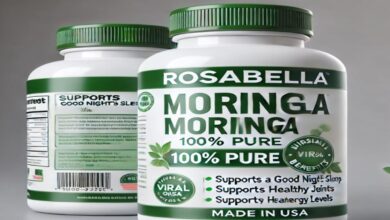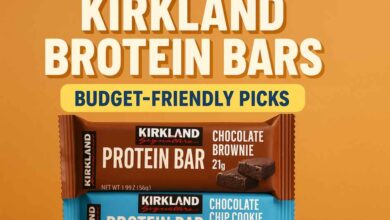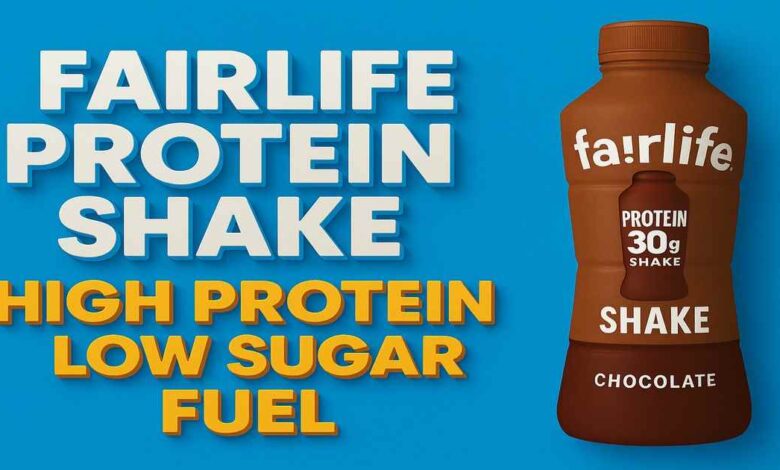
Busy lives need simple solutions. A ready-to-drink protein shake that delivers a high dose of protein with few calories and low sugar checks a lot of boxes: quick recovery after exercise, a portable snack to curb hunger, or an easy way to hit daily protein goals. The fairlife protein shake has become a popular option because it typically provides around 30 grams of protein, roughly 150 calories, and low sugar per bottle — numbers that appeal to athletes, busy parents, and anyone who wants a filling, low-sugar choice.
What is The fairlife protein shake?
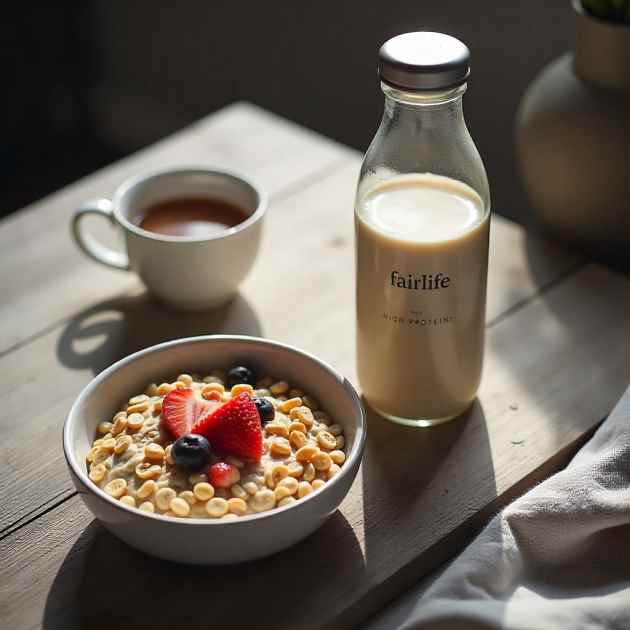
The fairlife protein shake is part of Fairlife’s line of nutrition-focused dairy products. Fairlife uses an ultra-filtration process on milk to concentrate protein and reduce sugar while keeping a creamy dairy taste. The Nutrition Plan bottles are commonly sold in flavors like chocolate, vanilla, and café latte, and they come in single-serve bottles (about 11–11.5 fl oz). Fairlife markets these bottles as high-protein, low-sugar, and lactose-free.
Key quick facts
- Typical serving: 11–11.5 fl oz (single bottle).
- Protein: around 30 g per serving.
- Calories: about 150 per serving.
- Sugar: low — often around 2 g per serving.
- Lactose-free claim: yes, due to ultra-filtration.
These numbers make the fairlife protein shake competitive in the ready-to-drink protein market — especially for people who want dairy-based protein with low sugar.
Nutrition Facts At a Glance
A simple, reader-friendly breakdown works best for quick skimming.
Per bottle (typical Nutrition Plan product)
- Protein: ~30 g
- Calories: ~150
- Sugar: ~2 g
- Fat: generally low (varies slightly by flavor)
- Other: contains naturally occurring vitamins and minerals from milk; some formulations list added vitamins and minerals
Why these numbers matter
- Around 30 grams of protein gives a significant amount that is frequently suggested for recovery after exercising.
- ~150 calories makes the shake a moderate snack or light meal replacement.
- ~2 g sugar is very low for a flavored dairy drink, which is attractive for readers tracking sugar intake.
When you showcase nutrition facts on your website, make sure to display the numbers prominently. Also, remind your readers to look at the bottle for the precise values linked to each flavor and SKU.
How Fairlife Compares to Major Competitors
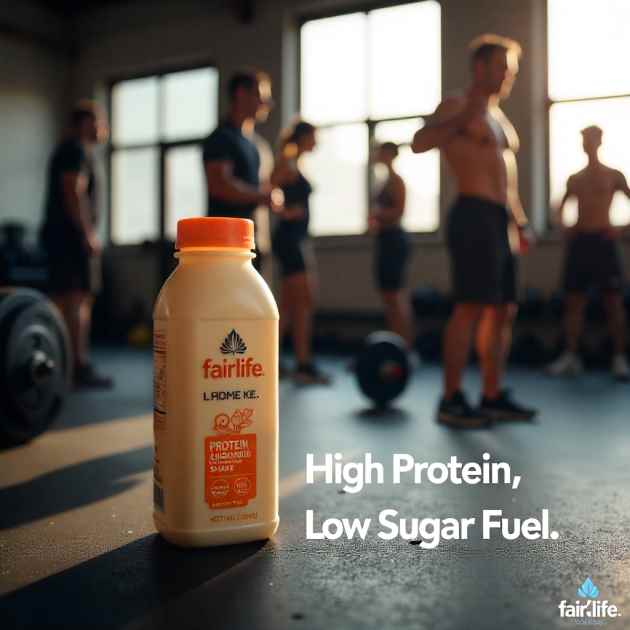
Readers want a short, direct comparison: “Is it better than X?” Below is a practical, plain-language comparison with common RTD (ready-to-drink) rivals.
Fairlife Nutrition Plan (typical)
- Protein: ~30 g | Calories: ~150 | Sugar: ~2 g
Premier Protein (typical RTD)
- Protein: ~30 g | Calories: ~160 | Sugar: 0–1 g
Muscle Milk (varies by product)
- Protein: ~25–32 g depending on the line | Calories: ~160–170 | Sugar: usually zero or very low in many SKUs
Short takeaways
- Fairlife and Premier Protein are very similar on protein and calories; differences are small on paper.
- Taste, mouthfeel, and ingredient preferences (natural vs artificial sweeteners, dairy vs non-dairy) usually decide shoppers more than a few calories.
- People who prefer a creamy, milk-forward flavor may favor Fairlife.
Taste, Texture, and User Reviews
What people commonly say: Most reviews describe Fairlife Nutrition Plan shakes as creamy, smooth, and milk-like — not chalky like some powder-based shakes mixed with water. Chocolate and vanilla are the most popular flavors, while café-latte attracts coffee lovers. Many buyers praise the texture and “milk-like” mouthfeel.
Common praise
- Creamy texture from ultra-filtered milk.
- Filling for relatively few calories.
Common complaints
- Price: RTD shakes cost more per serving than powder mixes.
- Sweetness preference: a few buyers dislike certain sweeteners or find particular flavors too sweet or not sweet enough.
Practical verdict on taste
If your reader values a creamy, dairy-like RTD protein option without chalkiness, the fairlife protein shake is likely to be well-liked. If price or a strictly plant-based diet is the priority, other options may fit better.
Ingredients, Sweeteners and Allergy info
Because Fairlife uses an ultra-filtration process on milk, these shakes are marketed as lactose-free while remaining dairy-based. That makes them a good fit for people with lactose intolerance who can tolerate milk proteins, but they are not suitable for people with a milk allergy.
Common ingredient notes
- Ultra-filtered milk is the primary protein source.
- Flavoring varies by SKU (cocoa for chocolate, coffee elements for café-latte).
- Sweeteners vary — some formulations use natural sweeteners while others may include different sugar alternatives.
- Added vitamins and minerals may be present depending on the product line.
Allergy notes
- The product contains milk protein; people with a milk allergy should avoid it.
- Lactose-free does not equal free of milk allergens. Always check the allergen label.
Who Should Use fairlife protein shake?
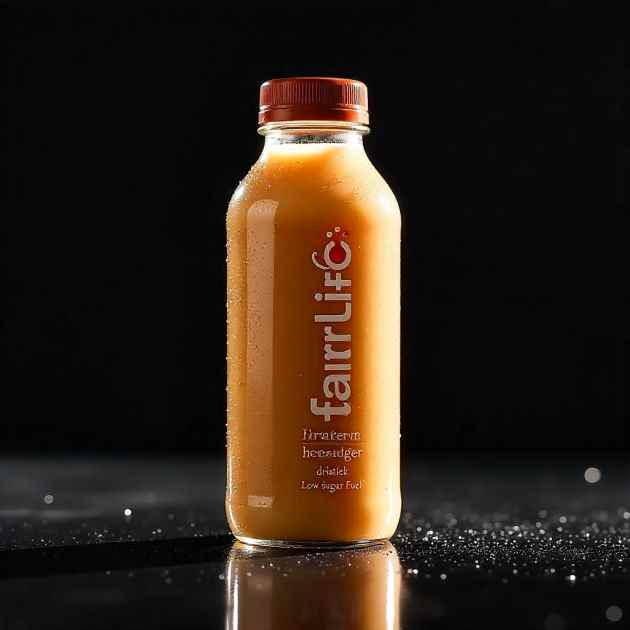
This is one of the most useful sections for readers who want practical guidance.
Great fit for:
- Gym-goers and athletes who want a quick 30 g protein hit after resistance training.
- Busy people who need a portable, filling snack with low sugar.
- People sensitive to lactose but okay with milk proteins.
Not a great fit for:
- People with a milk allergy.
- Those who follow strict plant-based diets.
- Buyers on a tight budget who prefer powdered protein for better cost-per-gram value.
How to fit into daily protein goals
If someone aims for, say, 120 g of protein a day, one fairlife protein shake covers roughly a quarter of that total. Mix with meals and snacks to spread protein throughout the day.
Pros and Cons — quick checklist
Pros
- High protein (around 30 g).
- Low sugar (around 2 g).
- Lactose-free due to ultra-filtration.
- Creamy, milk-like texture preferred by many.
Cons
- Higher price per serving than powders.
- Some shoppers care about sourcing and supply-chain issues.
- Not appropriate for those following a vegan diet or individuals with lactose intolerance.
Price, availability and best places to buy
Fairlife Nutrition Plan bottles are widely available in grocery chains, warehouse stores, and online retailers. Prices vary by retailer, pack size, and local deals. Purchasing multipacks or bulk packs usually reduces the cost for each bottle.
Price tips
- Compare per-bottle price when buying singles vs multi-packs.
- Look for in-store coupons or online discounts to lower cost.
- Warehouse stores often offer better per-unit values.
Animal Welfare, transparency and known reporting
This section addresses supply-chain concerns clearly and fairly.
What readers should know
Investigative reports and footage in past years raised allegations of animal-welfare issues at some supplier farms connected to Fairlife’s supply chain. Those reports led to public scrutiny, retailer reactions, and legal actions. In response, Fairlife and its corporate owners issued statements, cut ties with implicated suppliers, and described steps they were taking to improve oversight.
How to present this in an article
- Summarize the reporting factually: what was reported, what actions were taken, and what company statements said.
- Avoid sensational language. Present the timeline of events and official responses so readers can judge for themselves.
- For readers who care about ethical sourcing, encourage looking for up-to-date corporate policies and third-party audits.
Why this matters to readers
Consumers who prioritize animal welfare or sustainable sourcing may weigh these concerns when deciding whether to buy. Giving a balanced summary helps readers make informed choices rather than relying on one-sided claims.
Brand and Market Context — Coca-Cola and Fairlife’s growth
Fairlife launched with the promise of ultra-filtered milk products and expanded into the high-protein RTD market. Coca-Cola later acquired the business, integrating Fairlife into a larger distribution and marketing system. This corporate backing has helped Fairlife reach wide retail distribution and scale product offerings.
What this means for consumers
Bigger corporate ownership typically means wider availability and steady supply. It also means that large-scale supply-chain issues can attract broader public attention and potentially stronger corporate responses when problems are reported.
How to Use Fairlife Protein Shake: quick recipes and ideas
Fairlife works well straight from the bottle, but it’s also versatile in simple recipes.
- Post-workout recovery
Drink a bottle plain after training for a quick protein boost. - Smoothie base
Blend 1 bottle fairlife protein shake with ½ banana, a handful of spinach, and ice for a fiber-rich smoothie. - Protein coffee
Add the shake to iced coffee for an easy café-style drink. - Protein pancakes
Replace part of the milk in pancake batter with the shake to up the protein content of breakfast pancakes.
For each mix, tell readers to adjust portion sizes and calculate calories and macros if they track nutrition closely.
Cost Per Gram of Protein — a simple value check
A quick cost-per-gram calculation helps readers decide if RTD shakes fit their budget.
Example method
- Find per-bottle retail price (prices vary widely).
- Divide price by grams of protein. For example, $3.00 per bottle / 30 g protein = $0.10 per gram.
What this shows
RTD convenience costs more. For people valuing speed and portability, the premium is often worth it. For budget-conscious users who can mix shakes, powdered protein usually offers lower cost per gram.
Final Verdict — who should buy and who should skip
Buy the fairlife protein shake if:
- You want a dairy-based RTD shake with about 30 g protein and low sugar that tastes creamy and requires no mixing.
- You are lactose-intolerant but can tolerate milk proteins.
- Convenience and mouthfeel are priorities.
Skip or be cautious if:
- You have a milk allergy or follow a strict plant-based diet.
- Price is a major concern — consider powders or multi-pack deals.
- Ethical sourcing and animal welfare are deal-breakers for you — read current reporting and company policies before deciding.
Final Notes
This refined article removes links and any code while keeping the original structure, facts, and user-friendly tone. It aims to be balanced and easy to read while giving practical guidance to shoppers and fitness-minded readers. If you’d like, I can now:
- Format this for your CMS with headings, image captions, and a short author bio;
- Add a printable summary box or a downloadable checklist;
- Expand any section into a deeper 1,200–2,500 word sub-article (for example, a detailed timeline and reporting on supply-chain issues, or a full taste-test comparison with multiple RTD brands).
FAQs
What amount of protein can be found in a fairlife protein shake?
About 30 grams per bottle in the Nutrition Plan line.
Is fairlife protein shake lactose-free?
Yes, Fairlife markets these ultra-filtered milk products as lactose-free.
How does fairlife compare to Premier Protein?
Both deliver roughly 30 g of protein; differences in calories and sugar are small. Taste and ingredient preferences usually determine the winner for individual shoppers.
Is Fairlife owned by a major company?
Fairlife is owned by a large corporate parent, which has broadened its distribution.
Has Fairlife faced controversies?
There have been reports and investigations related to supplier animal-welfare practices in the past; Fairlife and its corporate owners have issued responses and described corrective steps.


